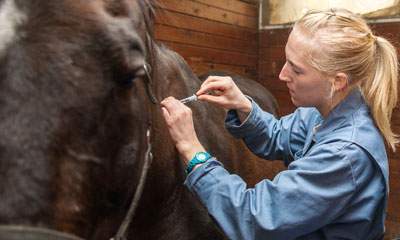
Vaccinating your horse
Every horse is an individual, so please discuss your animal’s specific needs and your region’s specific vaccine requirements with your veterinarian
Core vaccines
Core vaccines are important for all horses in a specific area, regardless of their lifestyle
Tetanus toxoid
- Tetanus causes difficulty eating and swallowing, lockjaw and muscle rigidity
- Horses are very susceptible to disease. Its most common infection route is through a puncture wound
- Available as a combination vaccine or on its own
West Nile virus (WNV)
- Mosquito-transmitted disease that causes a range of symptoms from flu-like symptoms to neurological disease
- No treatment other than supportive care
- Available as a combination vaccine or on its own
Eastern and western equine encephalitis (EEE and WEE)
- Mosquito-transmitted diseases that cause severe neurological signs
- Consistent and widespread vaccination have almost eradicated these diseases in North America
- Available as combination vaccines only
Rabies
- Virus is transmitted from the bite, or saliva, of an infected animal. The disease has three forms:
- furious (causing aggressive behaviour)
- dumb (causing depression)
- paralytic (causing paralysis)
- Horses are rarely infected, but the exposure of
an unvaccinated animal to a rabid animal results in a long period of quarantine (60 days) or immediate euthanasia. - Vaccine available on its own and must be administered by a veterinarian
Risk-based vaccines
Veterinarians recommend these vaccines based on the lifestyle of the horse and the risk of contracting each disease
Influenza (flu)
- Flu virus causes fever, nasal discharge, lethargy and a dry cough
- Highly contagious among horses, especially young ones
- Different vaccines to target European and North American virus strains
- Vaccine recommended for horses that travel or are stabled in a facility where horses are moving in and out
- Available alone as an intranasal vaccine or in combination vaccines
Equine herpesvirus 1 and 4 (rhino)
- Equine herpesvirus causes rhinopneumonitis (rhino), a highly contagious viral disease
- Most commonly causes respiratory symptoms in horses, but it also causes abortions in pregnant mares and neurological signs
- Once a horse is infected, the virus can remain latent and then reappear when the horse is under stress
- Vaccines do not protect against the disease’s neurological form
- Vaccine recommended for horses that travel or are stabled in a facility where horses are moving in and out
- Available alone as an intramuscular vaccine or in combination vaccines
- Specific vaccine for pregnant mares
Strangles
- Highly contagious disease among horses, especially young animals on breeding farms. Its clinical signs include:
- fever
- thick, white nasal discharge
- abscesses of the lymph nodes around the head
- Since some horses can carry the disease and spread it to others, the vaccine is recommended for horses that travel or are stabled in a facility where horses are moving in and out.
- Due to the risk of fatal side effects, exposed horses should not receive the strangles vaccine for at least five to 10 years after exposure unless an analysis of antibody titres (concentration levels) has been completed.
- Only available on its own as an intranasal vaccine
Vaccine combinations
Three-way + WNV
- Tetanus toxoid
- Western equine encephalitis (WEE)
- Eastern equine encephalitis (EEE)
- West Nile virus (WNV)
- Given intramuscularly with a booster shot one month after initial dose
- In subsequent years, given as an annual vaccine each spring before mosquito season
Five-way + WNV
- Tetanus toxoid
- Western equine encephalitis (WEE)
- Eastern equine encephalitis (EEE)
- Equine influenza virus (flu)
- Equine herpesvirus 1 and 4 (rhino)
- West Nile virus (WNV)
- Given intramuscularly with a booster shot one month after initial dose
- In subsequent years, given as an annual vaccine each spring before mosquito season
Two-way (flu/rhino)
- Equine influenza virus (flu)
- Equine herpesvirus 1 and 4 (rhino)
- Given intramuscularly with a booster shot one month after initial dose. Subsequent vaccines are given every
six months (spring and fall). - Different versions of this vaccine for different strains of flu:
- Version 1: Given to horses that are at risk for flu/rhino but not in contact with European horses. Fall “booster” if horse was given five-way + WNV in spring.
- Version 2: Given to horses that are at risk for flu/rhino but not in contact with European horses. Doesn’t work as “booster” to five-way + WNV vaccine combination.
- Version 3: Given to horses that are at risk for flu/rhino and are in contact with European horses. Doesn’t work as “booster” to five-way + WNV vaccine combination.
Individual vaccines
Ask your veterinarian for advice on what specific products to use
Rabies
- Given intramuscularly with an annual booster Tetanus toxoid
- Given intramuscularly with a booster shot one month after initial dose. Annual vaccine in subsequent years.
- Since most horses receive an annual tetanus vaccine in combination with other vaccines, tetanus toxoid is usually only given on its own to horses that have obtained wounds and had their last tetanus booster more than six months earlier.
Equine herpesvirus
- Given intramuscularly to pregnant mares at five, seven and nine months of gestation Equine influenza (flu)
- Given intranasally with a booster shot every six months (spring and fall). Vaccine does not need to be given if the horse received a flu/rhino combination vaccine.
Strangles
- Given intranasally with an annual booster shot

